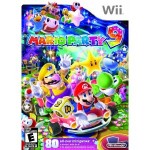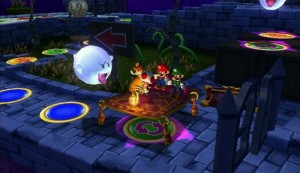Mario Party 9 (Wii)
 I was recently able to give the latest version of Mario Party a try, and put it through its paces. I have extremely fond memories of the first Mario Party title on the N64, spinning that little joystick like a madman to various goofy, yet fun, minigames. Players competed for stars within a quick series of matches or a strange sort of boardgame structure. The Bumper Balls minigame in particular was a masterpiece. It still remains the best gaming experience I can provide to a group of non-videogamers to demonstrate how fun the hobby can be. Unfortunately for me, Mario Party has since lost its way. The first few games did have random elements, but throughout successive generations of the title, luck became a greater and greater portion of the game. The newest incarnation, Mario Party 9, makes for a fine bit of four player family entertainment (I must admit we experienced occasional moments of hilarity, but they were most frequently due to the capricious nature of the game, rather than arising out of head to head competition.) Thus I cannot recommend the game for anyone seeking a game based upon true competition. It still stands as a valid game that does a good job of equalizing skill between different player abilities, but this is accomplished by its strong luck component rather than any more clever mechanisms.
I was recently able to give the latest version of Mario Party a try, and put it through its paces. I have extremely fond memories of the first Mario Party title on the N64, spinning that little joystick like a madman to various goofy, yet fun, minigames. Players competed for stars within a quick series of matches or a strange sort of boardgame structure. The Bumper Balls minigame in particular was a masterpiece. It still remains the best gaming experience I can provide to a group of non-videogamers to demonstrate how fun the hobby can be. Unfortunately for me, Mario Party has since lost its way. The first few games did have random elements, but throughout successive generations of the title, luck became a greater and greater portion of the game. The newest incarnation, Mario Party 9, makes for a fine bit of four player family entertainment (I must admit we experienced occasional moments of hilarity, but they were most frequently due to the capricious nature of the game, rather than arising out of head to head competition.) Thus I cannot recommend the game for anyone seeking a game based upon true competition. It still stands as a valid game that does a good job of equalizing skill between different player abilities, but this is accomplished by its strong luck component rather than any more clever mechanisms.
The game is standard Nintendo core-brand fare, with solid, cute graphics and all (most of) the familiar characters available to play or compete against. For those unfamiliar with the Mario Party franchise, the main gameplay revolves around rolling dice and then moving around a game board to collect stars, with occasional competitive mini-games that arise to provide additional stars to the winners. These mini-games are simple fare where players simply mash buttons as quickly as possible, make snap decisions about options, or bob and weave through some sort of obstacle course. In Mario Party 9, the players no longer move about the board on their own, but travel together in a big sort of car. This keeps all the players together, and since games are played from the start to the end of a board, games are satisfactorily shorter since players no longer need circle a board multiple times until the turn timer ends. The new version also focuses on collecting mini-stars rather than Stars. This is more than a graphical change, as previous games used to focus on collecting many coins which could be used to buy stars (among other things.) By dropping coins entirely and upping the number of stars available, the game is slightly less prone to large swings of fortune due to a few stars changing hands. (Don’t be misled, there can still be large swings of fortune, but it is slightly toned down.) Finally, the game preserves the many things players can unlock (ie. purchase) with the mini-stars earned in games. All sorts of things, such as soundtrack music, new “cars” in which to ride, etc… This is the sort of thing that gives legs to what otherwise might be a pretty short-lived game. Gamers who like to collect and explore things will have a bit more reason to continue to replay the game.
On the flip side, Mario Party 9 is basically as random as ever. No one should go into the game expecting to win on skill (in decision making or mini-game competitions) alone. Skill in mini-games might account for 50% or more of one’s score, but there are plenty of ways for good or bad luck to swing one’s way. For example, at the final scoring players are given bonus stars for such things as “landing on the most action spaces” (a near completely random event) although I can acknowledge that bonus stars to the player who lost the most stars due to collecting “negative” stars is a pretty good bonus to even out a bit of bad luck… As someone who loves boardgames, especially ones with interesting decisions, the entire idea and implementation of Mario Party 9 as being slightly boardgame-related makes my skin crawl. There are almost no valid decisions to be made during the game, it is simply a roll the dice and move sort of game while all the players are along for the ride. This doesn’t make it a bad game, but it makes it less of a game that is interesting to me. Finally, Mario Party 9 fails to take advantage of the Wii controller. It is inexcusable for a game this late in the development cycle to come along and require most of its mini-games to be controlled by holding the Wiimote sideways and using the d-pad (the little “plus” sign arrows.) What is this, the 90s? Sure, there are a few games (like picking turnips by flicking the controller and “grabbing” with the A & B buttons) that use the Wiimote well, but there are far too many that fall flat with old-school controls.
In the end, Mario Party 9 has a few new features, perhaps its best feature is the shorter game lengths due to the boards that have a definitive start and ending. I don’t feel this is enough to recommend it to anyone with a previous version of the game. However, this sort of casual gameplay is what the Wii is all about. If you are looking for a VERY casual title that will include the entire family and are not easily frustrated by results beyond your control, Mario Pary 9 might be worth a look. While youngsters may (but not necessarily) get bested on some of the mini-games, the random nature of the rest of the game still provides them a chance to stay in the running.






Discussion Area - Leave a Comment